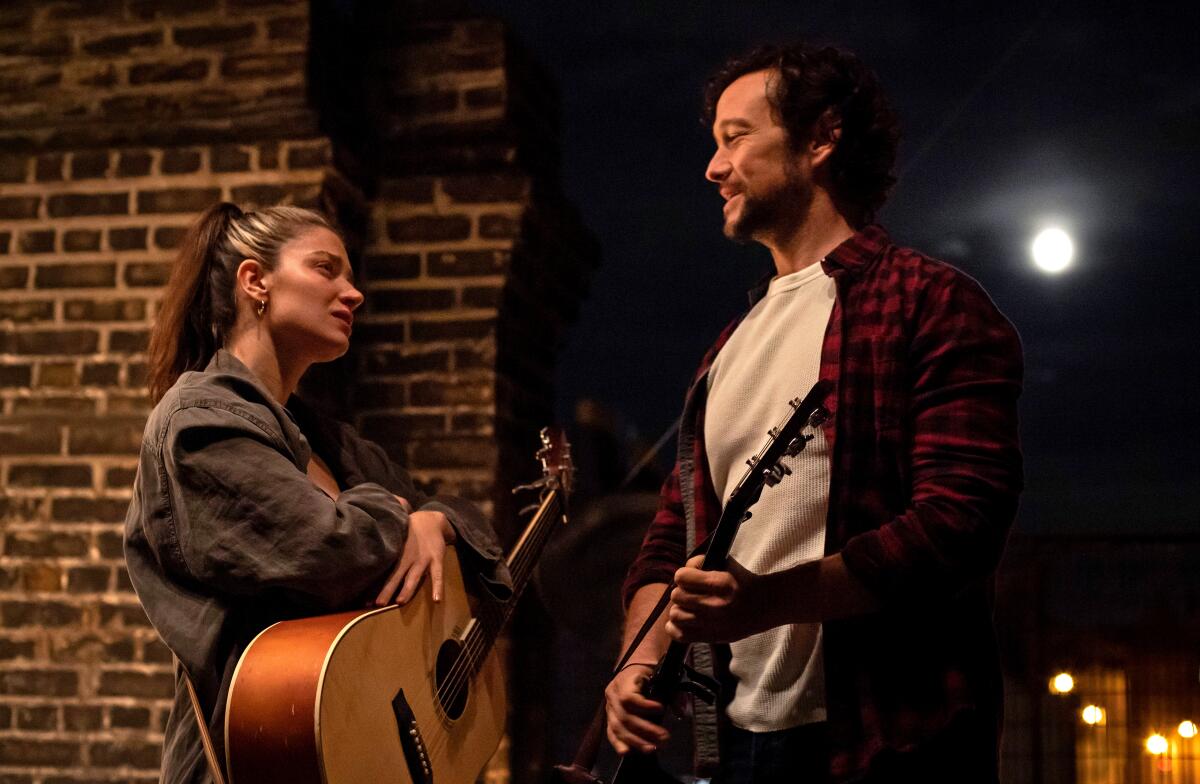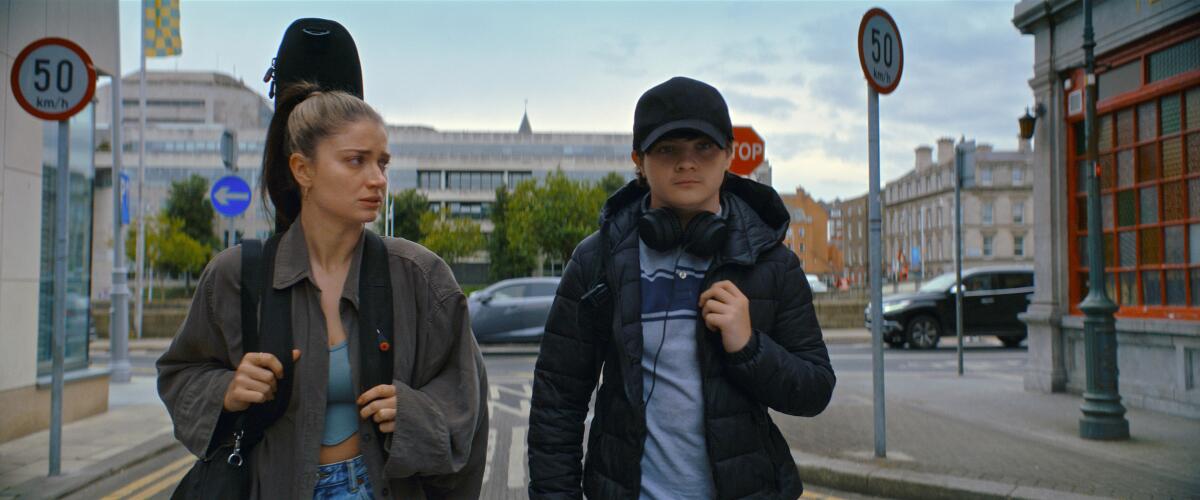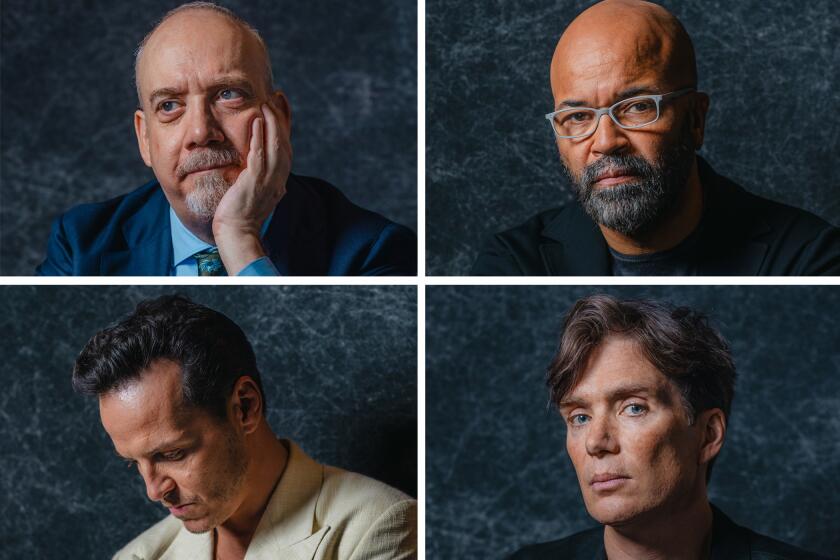A deep dive into three key songs from ‘Flora and Son’

- Share via
The characters don’t burst into song backed by invisible orchestras, but writer-director John Carney’s “Flora and Son” is a musical in perhaps a truer sense: It’s about people who are changed by music, so its many songs (mostly penned by Carney with singer-songwriter Gary Clark) are crucial to both story and characters. Three are so integral — and beautiful in their ways — that each deserves attention.
Flora, played with brio by Eve Hewson, is a single mother in Dublin with a fractious relationship with troublemaking teen son Max (Orén Kinlan). She rescues a guitar from a dumpster as a present for the boy, and when he rejects it, she defiantly takes it up herself. Mother and rapper son separately experience musical awakenings. Flora meets Jack (Joseph Gordon-Levitt), an online guitar teacher from the canyons of Los Angeles. She boldly rewrites one of his songs, eventually trading verses back and forth. As they fall for each other across eight time zones, it becomes one of the film’s hinge moments: “Meet in the Middle.”
“Now that was a real journey, that song,” says Clark, who despite working with the likes of Natalie Imbruglia, Liz Phair, Eddi Reader and Demi Lovato, may still be best known for his 1987 hit with his band, Danny Wilson: “Mary’s Prayer.” He and Carney have collaborated on three projects now, including “Sing Street” and the Amazon series “Modern Love.” He says “Meet in the Middle,” which along with the film’s “High Life” has been submitted by Apple for Oscar consideration, started from a melody and guitar part John had.
“The actors were uncomfortable with some of the lines. John had this idea: ‘Let’s just go into the studio and brainstorm, workshop this song in a day’ — John, myself, Joseph and Eve Hewson. They’d been playing their characters, so they knew who they were. We walked through each verse until we figured out who was doing what, the sparring. So it was almost like writing a bit of script.”
Our BuzzMeter film experts are back to predict what Oscar voters will nominate in 10 Academy Awards categories. Vote in the online polls!
“Yeah, it was interesting,” says Carney, who says his first love was music, and, let’s be honest, looks like he could be Declan McManus’ brother.
Clark says Carney wanted the chorus to “express their need to meet ... metaphorically, but also physically. I just started singing the ‘Maybe we should meet in the middle’ bit.”
Carney says, “You suggested it as a piss take! I was like, ‘No, that’s kind of it!’ We didn’t want a normal duet, like a Barbra Streisand-Kris Kristofferson thing.”
“The closest reference for us was more like the Pogues with Kirsty MacColl doing —”
“— our Irish national anthem as we call it,” says Irishman Carney, “ ‘Fairytale of New York’ —”
“— where they’re kind of sparring rather than singing together,” says Scotsman Clark.

Indeed, after Jack’s poetic daydream of driving Flora around Topanga, she follows in the same pretty melody with, “I’ll take you down to Dollymount / And we’ll f— behind the dunes / I’ll kiss your mouth, all whiskey breath / And then I’ll leave your heart in ruins.”
Carney says, “We thought these characters should not agree. The only thing they’re in agreement with is where to harmonize. The lyrics are sparking off each other.”
They sing together over matching acoustic guitars, “Maybe we should meet in the middle / Maybe we could find a little city no one knows / And if we just gave us a minute on our own / Maybe we could call it homе.”
At the end of the September-released film, and the other end of the musical spectrum, “High Life” culminates the central mother-son story. They collaborate on a celebration of their street-level spirit, showing off how far their musical skill — and their relationship — has come. While it’s an upbeat pop song with a full band, its rough edges show. They’re not playing it to win Eurovision or get a record contract; they’re just getting up for the first time in front of a pub crowd.
The grubby truths that inform Carney’s movies, like 2007’s “Once,” are all over it. Flora sings to her son before a full house, “This song’s a love song / It’s not an apology / But sometimes I hate you / Reminding me of me.” But she adds, “And I’m not living in your life / And you’re not living in mine / And this song’s for all you mothers / We’re all gonna be just fine,” revealing how her understanding of their relationship has evolved.
Carney says, “We wanted all the joy of a big ending musical number, but really plausible and low key. All they’re doing is playing a song in a pub in Dublin around the corner from their house that isn’t absolutely s—. And the audience aren’t going, ‘What the f—?’ ”
Clark says the playback track, “was much tighter, more polished. When we watched [with] that music, we realized we wanted to make it feel more like what you were seeing. We went back and loosened up the guitar, added some live drums.”

And that’s the end of the story. But not really. Viewers should stick around for the credits to hear the song Jack promised Flora. Clark says they shot a scene in which Flora hears it, but felt it detracted from the mother-son story. So the lights go out, and over nothing but white-lettered credits rising on a black background, we get the longing of a distant not-yet lover: “Talking to You.”
“If I said purple, you’d say red / With your brown hair tumbling like an unmade bed / And we’d both die laughing at something I said / Talking to you.”
Carney says, “It was the first song Gary sent me and I was like, ‘This is going all over this movie. It’s perfect.’ I even thought about changing the title of the movie to ‘Talking to You.’ It sounds really simple on the guitar, but I can’t play it — the complex jazz chords.”
“If god takes me and leaves you here / I want no black limousines and no sad tears / ‘Cause I’ll still be hanging ‘round the atmosphere / Talking to you / And no words or music can come even near / To talking to you.”
“Some songs just come really quickly,” says Clark. “You get to a point where a lyric, just on the page, you could see it and go, ‘OK I can’t get it any better than that.’ ”
More to Read
From the Oscars to the Emmys.
Get the Envelope newsletter for exclusive awards season coverage, behind-the-scenes stories from the Envelope podcast and columnist Glenn Whipp’s must-read analysis.
You may occasionally receive promotional content from the Los Angeles Times.












